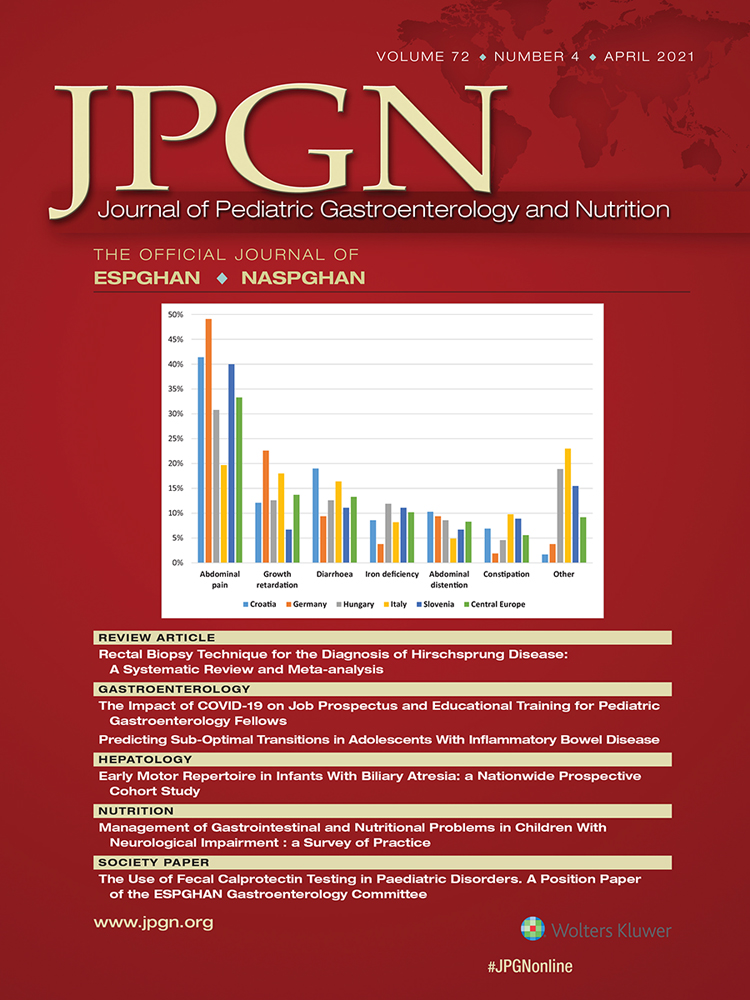Dairy Fat Intake, Plasma Pentadecanoic Acid, and Plasma Iso-heptadecanoic Acid Are Inversely Associated With Liver Fat in Children
Supplemental digital content is available for this article. Direct URL citations appear in the printed text, and links to the digital files are provided in the HTML text of this article on the journal's Web site (www.jpgn.org).
The project was partially supported by grants from the National Institutes of Health, Grants UL1TR000100 and UL1TR001442, National Dairy Council, and the Camille and Henry Dreyfus Foundation. The funders did not participate in the conduct of the study; collection, management, analysis, and interpretation of the data; and preparation of the manuscript. The content is solely the responsibility of the authors and does not necessarily represent the official views of the NIH, National Dairy Council, or the Camille and Henry Dreyfus Foundation.
M.C.S., M.W., E.S., N.P.G., K.P.N., E.L.Y., C.B., J.D., C.K., J.A.G., B.A.B., J.M.G., N.M., A.S., C.M.M. report no conflicts of interest. M.S.M. consults for Bracco, Kowa, Median, Merge Healthcare, Novo Nordisk, Quantitative Insights; and has grant funding from Gilead and Guerbet. C.B.S. received grant funding from Bayer, GE, Philips, and Siemens; consults for AMRA, Boehringer, and Guerbet; is on the speaker's bureau for Resoundant and has lab service agreements with Gilead, ICON, Intercept, Shire, and Synageva. J.B,S. received grant funding from Galmed, Intercept, and Genfit.
ABSTRACT
Objectives:
We sought to evaluate the relevance of pediatric dairy fat recommendations for children at risk for nonalcoholic fatty liver disease (NAFLD) by studying the association between dairy fat intake and the amount of liver fat. The effects of dairy fat may be mediated by odd chain fatty acids (OCFA), such as pentadecanoic acid (C15:0), and monomethyl branched chain fatty acids (BCFA), such as iso-heptadecanoic acid (iso-C17:0). Therefore, we also evaluated the association between plasma levels of OCFA and BCFA with the amount of liver fat.
Methods:
Observational, cross-sectional, community-based sample of 237 children ages 8 to 17. Dairy fat intake was assessed by 3 24-hour dietary recalls. Plasma fatty acids were measured by gas chromatography-mass spectrometry. Main outcome was hepatic steatosis measured by whole liver magnetic resonance imaging proton density fat fraction (MRI-PDFF).
Results:
Median dairy fat intake was 10.6 grams/day (range 0.0--44.5 g/day). Median liver MRI-PDFF was 4.5% (range 0.9%–45.1%). Dairy fat intake was inversely correlated with liver MRI-PDFF (r = −0.162; P = .012). In multivariable log linear regression, plasma C15:0 and iso-C17:0 were inverse predictors of liver MRI-PDFF (B = −0.247, P = 0.048; and B = −0.234, P = 0.009).
Conclusions:
Dairy fat intake, plasma C15:0, and plasma iso-C17:0 were inversely correlated with hepatic steatosis in children. These hypothesis-generating findings should be tested through clinical trials to better inform dietary guidelines.




